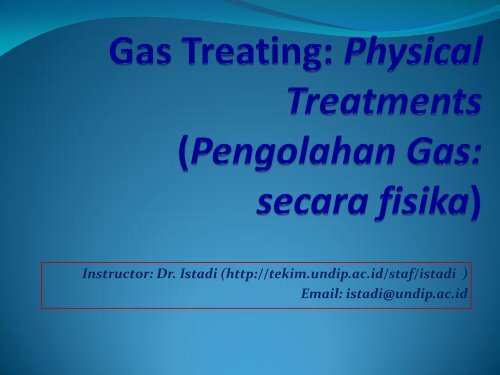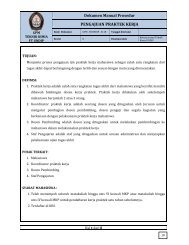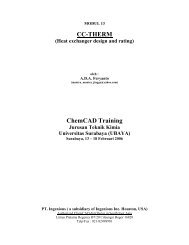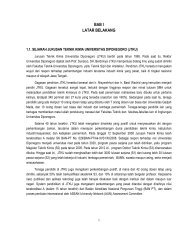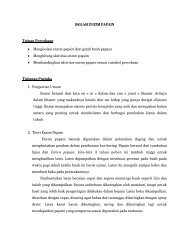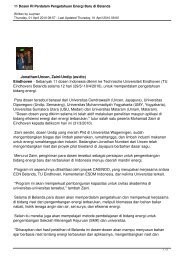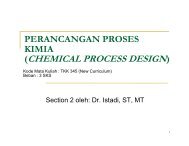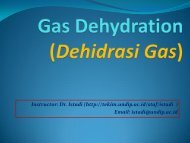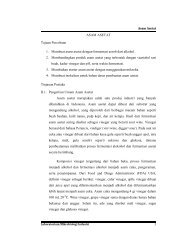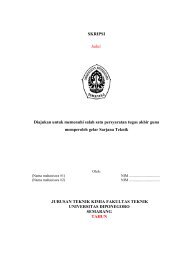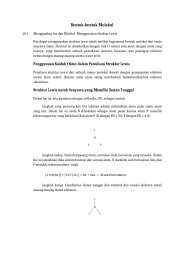Instructor: Dr. Istadi (http://tekim.undip.ac.id/staf/istadi ) Email: istadi ...
Instructor: Dr. Istadi (http://tekim.undip.ac.id/staf/istadi ) Email: istadi ...
Instructor: Dr. Istadi (http://tekim.undip.ac.id/staf/istadi ) Email: istadi ...
Create successful ePaper yourself
Turn your PDF publications into a flip-book with our unique Google optimized e-Paper software.
<strong>Instructor</strong>: <strong>Dr</strong>. <strong>Istadi</strong> (<strong>http</strong>://<strong>tekim</strong>.<strong>undip</strong>.<strong>ac</strong>.<strong>id</strong>/<strong>staf</strong>/<strong>istadi</strong> )<br />
<strong>Email</strong>: <strong>istadi</strong>@<strong>undip</strong>.<strong>ac</strong>.<strong>id</strong>
PHYSICAL ABSORPTION<br />
� Absorption processes are generally most efficient when<br />
the partial pressures of the <strong>ac</strong><strong>id</strong> gases are relatively<br />
high, because partial pressure is the driving force for the<br />
absorption.<br />
� Heavy hydrocarbons are strongly absorbed by the<br />
solvents used, and consequently <strong>ac</strong><strong>id</strong> gas removal is<br />
most efficient in natural gases with low<br />
concentrations of heavier hydrocarbons.<br />
� Solvents can be chosen for selective removal of sulfur<br />
compounds, which allows CO 2 to be slipped into the<br />
res<strong>id</strong>ue gas stream and reduce separation costs.<br />
� Energy requirements for regeneration of the solvent<br />
are lower than in systems that involve chemical<br />
re<strong>ac</strong>tions.
� Separation can be carried out at near-ambient<br />
temperature.<br />
� Partial processes produce a water saturated product<br />
stream that must be dried in most applications.<br />
� Organic liqu<strong>id</strong> (solvents) are used in these processes<br />
to absorb H 2S (usually) preferentially over CO 2 at high<br />
pressure and low temperatures.<br />
� Regeneration is carried out by releasing the pressure to<br />
the atmosphere and sometimes in v<strong>ac</strong>uum with no heat.
Properties of Physical Solvents
SELEXOL PROCESS<br />
� Selexol is a typical application of physical absorption<br />
that uses a mixture of dimethyl ether and propylene<br />
glycols as a solvent.<br />
� A cool stream of natural gas is injected in the bottom of<br />
the absorption tower operated at 1000 psia.<br />
� The rich solvent is flashed in a high flash drum at 200<br />
psia, where methane is flashed and recycled b<strong>ac</strong>k to the<br />
absorber and joins the sweet gas stream.<br />
� The solvent is then flashed at atmospheric pressure and<br />
<strong>ac</strong><strong>id</strong> gases are flashed off.
Selexol…<br />
� The solvent is then stripped by steam to completely<br />
regenerate the solvent, which is recycled b<strong>ac</strong>k to the<br />
absorber; any hydrocarbons will be condensed and any<br />
remaining <strong>ac</strong><strong>id</strong> gases will be flashed from the<br />
condenser drum.<br />
� This process is used when there is a high <strong>ac</strong><strong>id</strong> gas<br />
partial pressure and no heavy hydrocarbons.<br />
� DIPA (di-isopropanol amine) can be added to this<br />
solvent to remove CO2 down to pipeline specifications
Selexol Process Schematic
K i = P i sat /P<br />
y i.P = x i. P i sat<br />
K-Value<br />
� R k Value = K-value methane /<br />
K-value component<br />
� The K-value is the ratio of the<br />
mole fr<strong>ac</strong>tion of the component<br />
in the vapor phase (y) to its<br />
mole fr<strong>ac</strong>tion in the liqu<strong>id</strong><br />
phase (x), K = y/x.<br />
� High K-values indicate the<br />
material is predominately in<br />
the vapor phase, whereas low<br />
K-values indicate a higher<br />
concentration in the liqu<strong>id</strong><br />
phase (x).
R k Value - Selexol<br />
� An R k value greater than unity indicates the solubility of the<br />
component in Selexol is greater than that of methane, whereas<br />
a value less than unity indicates the opposite<br />
� Because R K for CO 2 and H 2S are 15 and 134, respectively, these gases<br />
are preferentially absorbed (relative to CH 4), and, consequently,<br />
physical absorption is an effective technique for <strong>ac</strong><strong>id</strong> gas removal.<br />
� The process can reduce H 2S to 4 ppmv, reduce CO 2 to levels below<br />
50 ppmv, and essentially remove all mercaptans, CS2, and COS.<br />
� R K values for hydrocarbons heavier than CH4 are fairly high<br />
(6.4 for C2H6, 15.3 for C3H8, and 35 for n-C4H10), Selexol will<br />
remove substantial quantities of these hydrocarbons, a feature that<br />
can be either positive or negative, depending on the composition of<br />
the gas being processed and the desired products.<br />
� Finally, the R K value of H2O is extremely high and consequently,<br />
Selexol prov<strong>id</strong>es some dehydration
Solubility of various gases in Selexol solvent at<br />
70°F (21°C) as a function of partial pressure<br />
� For an <strong>id</strong>eal system,<br />
Henry’s law assumes<br />
a linear relation<br />
between the<br />
solubility of gas<br />
component i and its<br />
partial pressure,<br />
� y i.P = H i.x i<br />
� where H i is the<br />
Henry’s constant.
HENRY’S LAW<br />
� P i = H.X i or X i = (Y i / H).P<br />
� This implies that <strong>ac</strong><strong>id</strong> gas absorbed in liqu<strong>id</strong><br />
phase (X i) is proportional to its gas mole fr<strong>ac</strong>tion (Y i)<br />
and inversely to Henry’s constant (which is constant<br />
for a given temperature).<br />
� Much more importantly, the solubility is proportional<br />
to the total gas pressure (P).<br />
� This means that at high pressure, <strong>ac</strong><strong>id</strong> gases will<br />
dissolve in solvents, and as the pressure is released,<br />
the solvent can be regenerated.
Example: Composition of Inlet and<br />
Outlet Gas in a Selexol Unit
FLUOR PROCESS<br />
� This process uses propylene carbonate to remove CO 2, H 2S,<br />
C 2 + , COS, CS2, and H 2O from natural gas.<br />
� Thus, in one step, the natural gas can be sweetened and<br />
dehydrated.
Purisol Process<br />
� This process uses N-methyl-2-pyrrol<strong>id</strong>one also known as<br />
NMP as a solvent (licensed by Lurgi).<br />
� The solvent removes H 2S, CO 2, H2O, RSH, and<br />
hydrocarbons and elastomers.<br />
� The feature of this solvent is that it is highly selective for<br />
H 2S.<br />
� It has a boiling point of 396 o F, which is rather low to be used<br />
in amine mixed solvents.<br />
� Regeneration is <strong>ac</strong>complished by two strippers, where<br />
dissolved hydrocarbons are stripped off as fuel gas nitrogen in<br />
the first drum<br />
� and <strong>ac</strong><strong>id</strong> gases are stripped in the second stripper;<br />
� regenerated NMP is recycled b<strong>ac</strong>k to the absorber.
Purisol Process Scheme
Sulfinol/Claus Process<br />
� This process uses a solvent which is 40% sulfolane (tetrahydrothiophene<br />
1-1 diox<strong>id</strong>e), 40% DIPA (di-isopropanolamine), and 20% water.<br />
� Enhancing amine selectivity by adding a physical solvent such as sulfolane.<br />
Sulfolane is an excellent solvent of sulfur compounds such as H 2S,<br />
COS, and CS 2. Aromatics, heavy hydrocarbons, and CO 2 are soluble to a<br />
lesser extent.<br />
� Sulfinol is usually used for H 2S/CO 2 ratios greater than 1:1 or where CO 2<br />
removal is not required to the same extent as H 2S.<br />
� The sour gas components are removed from the feed gas by countercurrent<br />
cont<strong>ac</strong>t with a lean solvent stream under pressure.<br />
� The absorbed impurities are then removed from the rich solvent by stripping<br />
with steam in a heated regenerator column.<br />
� The hot lean solvent is then cooled for reuse in the absorber absorber. Part<br />
of the cooling may be by heat exchange with the rich solvent for partial<br />
recovery of heat energy.
Sulfinol/Claus Process
Comparison of Physical Solvents<br />
� Purisol has the highest cap<strong>ac</strong>ity for absorption of <strong>ac</strong><strong>id</strong><br />
gases and it is the most selective; however, it is the most<br />
volatile.<br />
� Selexol is more selective than Fluor solvent, but it<br />
dissolves propane.<br />
� All solvents exhibit significant affinity for heavy paraffins,<br />
aromatics, and water.<br />
� Water absorption make them good dessicants.<br />
� The loading cap<strong>ac</strong>ity of physical solvent is much higher<br />
than amines.<br />
� From Figure: At partial pressure of H 2S 200 psia, the<br />
loading (mol H 2S/gal solvent) of MEA (20% solution) is<br />
about 11.5, and at the same time, sulfolane (physical<br />
solvent) is about 18 and sulfinol (which is a mixed<br />
solvent) is about 19.
Equilibrium solvent loadings
HYBRID PROCESSES<br />
� The strengths and weaknesses of amine and physical<br />
solvent system<br />
� To take advantage of the strengths of e<strong>ac</strong>h type, a number<br />
of hybr<strong>id</strong> processes commercially used, and under<br />
development, combine physical solvents with amines<br />
� Depending upon the solvent−amine combination, nearly<br />
complete removal of H 2S, CO 2, and COS is possible<br />
� Sulfinol®: The process uses a combination of a physical<br />
solvent (sulfolane) with DIPA or MDEA.<br />
� Like the physical solvent processes, the hybr<strong>id</strong> systems may<br />
absorb more hydrocarbons, including BTEX, but that<br />
property can be adjusted by varying water content.
ADSORPTION<br />
� Ac<strong>id</strong> gases, as well as water, can be effectively removed<br />
by physical adsorption on synthetic zeolites<br />
� Applications are limited because water displ<strong>ac</strong>es <strong>ac</strong><strong>id</strong><br />
gases on the adsorbent bed<br />
� From typical isotherms for CO 2 and H 2S on molecular<br />
sieve, indicates that at ambient temperatures substantial<br />
quantities of both gases are adsorbed even at low partial<br />
pressures<br />
� Molecular sieve can reduce H 2S levels to the 0.25<br />
gr/100 scf (6 mg/m 3 ) specification.<br />
� However, this reduction requires regeneration of the<br />
bed at 600°F (315°C) for extended time ?????
Schematic of integrated natural<br />
gas desulfurization plant<br />
� Dashed line denotes regeneration gas stream.
CRYOGENIC FRACTIONATION<br />
� Distillation � the most w<strong>id</strong>ely used process to<br />
separate liqu<strong>id</strong> mixtures<br />
� It seems a good prospect for removing CO2 and H2S<br />
from natural gas, because the vapor pressures of the<br />
principal components are different<br />
� However, problems are associated with the separation<br />
of CO2 from methane, CO2 from ethane, and CO2<br />
from H2S
Difference of Vapor Pressures
Distillation: CO 2 from methane<br />
� Relative volatilities (K C1/K CO2) at typical distillation<br />
conditions are about 5 to 1. Therefore one would expect<br />
simple fr<strong>ac</strong>tionation to work.<br />
� However, because the liqu<strong>id</strong> CO2 phase freezes when<br />
it becomes concentrated, the pr<strong>ac</strong>tical maximumvapor<br />
concentration of methane is only 85 to 90 mol%.
Distillation: CO 2 from ethane<br />
� In addition to sol<strong>id</strong>ification problems, CO2 and ethane<br />
form an azeotrope (liqu<strong>id</strong> and vapor compositions are<br />
equal) and<br />
� consequently, complete separation of these two by<br />
simple distillation is impossible
Distillation: CO 2 from H 2S<br />
� The distillation is difficult<br />
� The mixture forms a pinch at high CO2<br />
concentrations.<br />
� This separation by conventional distillation is<br />
complicated by the need to have an overhead product<br />
that has roughly 100 ppmv H2S if the stream is vented.<br />
� The bottoms product should contain less than twothirds<br />
CO2, assuming the stream is feed to a Claus<br />
unit.
Membrane Separation<br />
� Membranes are used in natural gas processing for dehydration, fuel-gas<br />
conditioning, and bulk CO 2 removal, but presently CO 2 removal is by far<br />
the most important application<br />
� Polymeric membranes separate gases by selective permeation of gas<br />
species in these membranes.<br />
� The gas dissolves at the cont<strong>ac</strong>t surf<strong>ac</strong>e of the membrane and<br />
permeate <strong>ac</strong>ross the membrane under the partial pressure gradient<br />
<strong>ac</strong>ross the membrane wall.<br />
� The basic <strong>id</strong>ea of the process is to flow sour gas on one s<strong>id</strong>e of the<br />
membrane where only <strong>ac</strong><strong>id</strong> gases diffuse <strong>ac</strong>ross the membrane to the<br />
permeate s<strong>id</strong>e and the rest of the gas exits as sweet gas
Rate of Permeation<br />
� The rate of permeation of gas A(q A) can be expressed<br />
as:<br />
� where PM is the gas permeability in the membrane,<br />
A m and t are the surf<strong>ac</strong>e area and thickness of the<br />
membrane, respectively, and ∆P A is the partial pressure<br />
of gas A <strong>ac</strong>ross the membrane.
CARBON DIOXIDE REMOVAL<br />
FROM NATURAL GAS<br />
� For CO2 removal, the industry standard is presently<br />
cellulose <strong>ac</strong>etate.<br />
� These membranes are of the solution-diffusion type, in<br />
which a thin layer (0.1 to 0.5 μm) of cellulose <strong>ac</strong>etate is on<br />
top of a thicker layer of a porous support material.<br />
� Permeable compounds dissolve into the membrane, diffuse<br />
<strong>ac</strong>ross it, and then travel through the in<strong>ac</strong>tive support<br />
material.<br />
� The membranes are thin to maximize mass transfer and,<br />
thus, minimize surf<strong>ac</strong>e area and cost, so the support layer is<br />
necessary to prov<strong>id</strong>e the needed mechanical strength.
Hollow Fiber Membrane
Spiral Wound Membrane
Gas flow paths for spiral-wound module
Single Stage CO 2/CH 4 Membrane Separation
Two-stage Membrane process
Feed Gas Pretreatment<br />
� Because membranes are susceptible to degradation<br />
from impurities, pretreatment is usually required.<br />
� The impurities possibly present in natural gas that<br />
may cause damage to the membrane
ADVANTAGES OF MEMBRANE<br />
SYSTEMS<br />
� Low capital investment when compared with solvent<br />
systems<br />
� Ease of installation: Units are normally sk<strong>id</strong><br />
mounted<br />
� Simplicity: No moving parts for single-stage units<br />
� High turndown: The modular nature of the system<br />
means very high turndown ratios can be <strong>ac</strong>hieved<br />
� High reliability and on-stream time<br />
� No chemicals needed<br />
� Good weight and sp<strong>ac</strong>e efficiency<br />
� Ease of operation: process can run unattended
DISADVANTAGES OF MEMBRANE SYSTEMS<br />
� Economy of scale: Because of their modular nature, they<br />
offer little economy of scale<br />
� Clean feed: Pretreatment of the feed to the membrane to<br />
remove particulates and liqu<strong>id</strong>s is generally required<br />
� Gas compression: Because pressure difference is the<br />
driving force for membrane separation, cons<strong>id</strong>erable<br />
recompression may be required for either or both the<br />
res<strong>id</strong>ue and permeate streams<br />
� For natural gas:<br />
� Generally higher hydrocarbon losses than solvent systems<br />
� H2S removal: H2S and CO2 permeation rates are roughly the<br />
same, so H2S specifications may be difficult to meet<br />
� Bulk removal: Best for bulk removal of <strong>ac</strong><strong>id</strong> gases; membranes<br />
alone cannot be used to meet ppmv specifications


